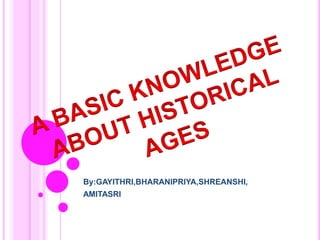Stone, Bronze and Iron Ages: A History of Early Civilizations
•Download as PPTX, PDF•
1 like•1,099 views
it is about t
Report
Share
Report
Share

More Related Content
What's hot
What's hot (20)
What The Water Gave Us: Ancient Mesopotamia & The Invention Of Writing

What The Water Gave Us: Ancient Mesopotamia & The Invention Of Writing
Viewers also liked
Viewers also liked (8)
Similar to Stone, Bronze and Iron Ages: A History of Early Civilizations
Similar to Stone, Bronze and Iron Ages: A History of Early Civilizations (20)
Stone, Bronze and Iron Ages: A History of Early Civilizations
- 4. :The Stone Age is a broad prehistoric period during which stone was widely used to make implements with a sharp edge, a point, or a percussion surface. The period lasted roughly 3.4 million years, and ended between 6000 BCE and 2000 BCE with the advent of metalworking.
- 6. The Bronze Age is a time period characterized by the use of bronze, proto-writing, and other early features of urban civilization. The Bronze Age is the second principal period of the three-age Stone- Bronze-Iron system, as proposed in modern times by Christian Jorgensen Thomsen, for classifying and studying ancient societies.
- 8. The Kassites were an ancient Near Eastern people who controlled Babylonia after the fall of the Old Babylonian Empire ca. 1531 BC and until ca. 1155 BC (short chronology). The Kassites gained control of Babylonia after the Hittite sack of the city in 1595 BC (i.e. 1531 BC per the short chronology), and established a dynasty based in Dur-Kurigalzu.
- 10. Timeline of ancient Greece. This is a timeline of Ancient Greece from 800 BC to 146 BC. For earlier times, see Greek Dark Ages, Aegean civilizations and Mycenaean Greece. For later times see Roman Greece, Byzantine Empire and Ottoman Greece.
